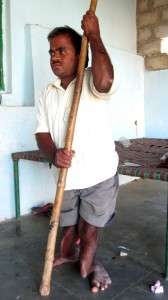Interview with Katya Cherukumilli by DNews on Youtube
Approximately 200 million people worldwide drink water with toxic levels of fluoride surpassing WHO’s permissible limit of 1.5 mg F-/L. The concentration of fluoride in groundwater is primarily determined by the natural dissolution of fluoride-rich granitic rocks. Exposure to fluoride levels above 1.5 mg/L can cause severe health repercussions, including anemia due to poor nutrient absorption, mottling of tooth enamel (dental fluorosis), and severe bone deformities in children (skeletal fluorosis). Globally, excess fluoride in groundwater has been reported in many countries including the arid regions of India, Sri Lanka, China, the East African Rift Valley, northern Mexico, and central Argentina. In India, over 66 million people are at risk of developing fluorosis and face large and adverse social, economic, and health repercussions.



Skeletal fluorosis patients in Nalgonda District, photo taken during Katya’s 2013 field visit
Particularly in the newest Indian state created in June 2014, Telangana, the Nalgonda District offers an appropriate site to study this global development challenge because the problem there is severe, long standing, and still largely unresolved. It is estimated that 10% (~0.35 million people) of the district population are affected by fluoride contamination and about 10,000 people are irreversibly crippled due to skeletal fluorosis. Despite awareness of the problem for over 6 decades, fluoride contamination in Nalgonda continues to persist due to lack of alternative water sources for the rural populations.
Although many defluoridation technologies have been proven to be effective in labs, few have been distributed in the field and even fewer appear to be sustainable long-term. A technology may not be appropriate for remote rural areas if it is labor intensive, difficult to scale up at the community level (a commonly cited problem of the ‘Nalgonda technique’), cost-prohibitive, difficult to source locally (e.g., reverse osmosis, activated alumina filters), culturally inappropriate (e.g., bone char), or unreliable (e.g., dilution through rainwater harvesting).
Our lab proposes to develop a novel defuoridation technology that meets the following requirements for a removal method: it is locally sourced and affordable, highly effective, culturally appropriate, technically feasible and robust in a rural setting, and requires minimal manpower to operate and maintain the system. We are investigating bauxite ore, the raw material for producing alumina and aluminum, as a potential sustainable fluoride removal method with lower material, energy, and carbon costs.
For additional information about this project, please contact Katya Cherukumilli at katyach@berkeley.edu.